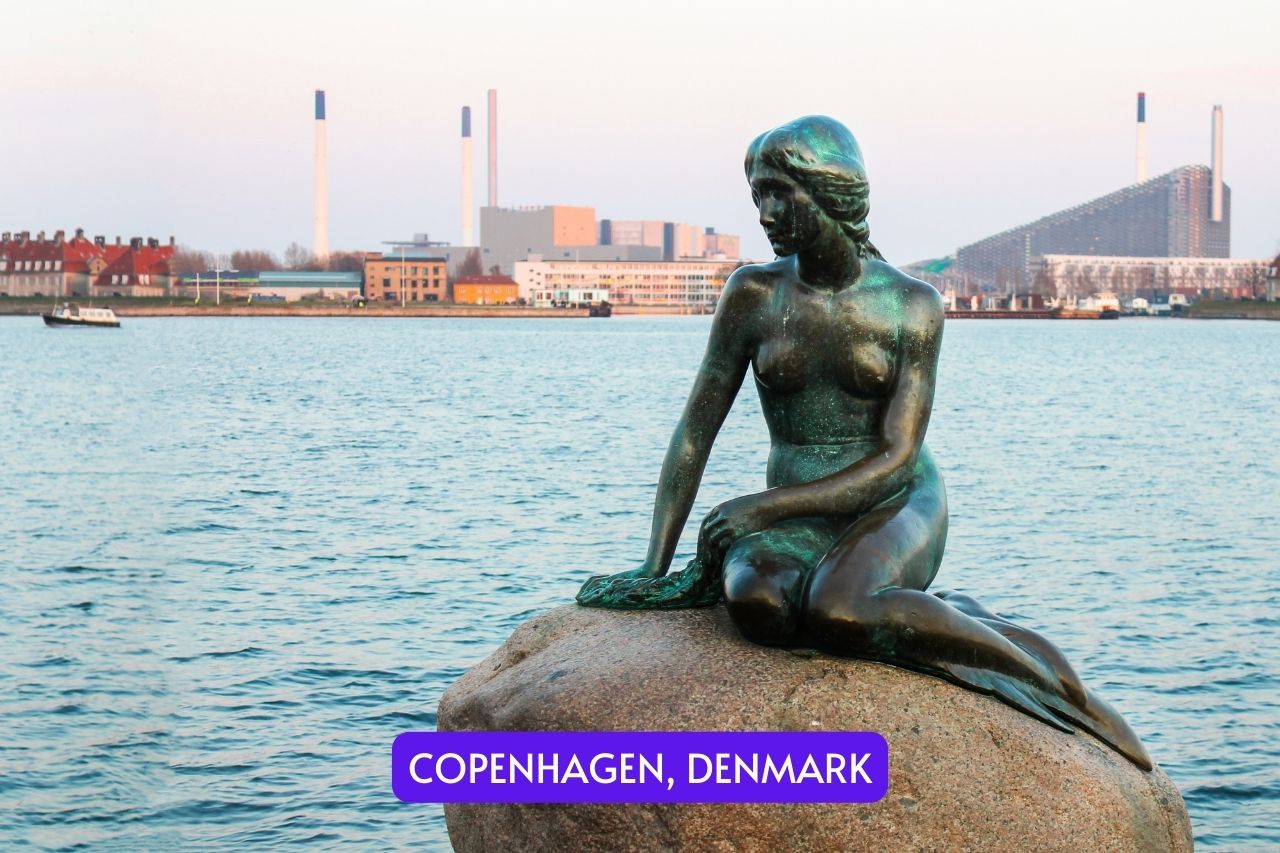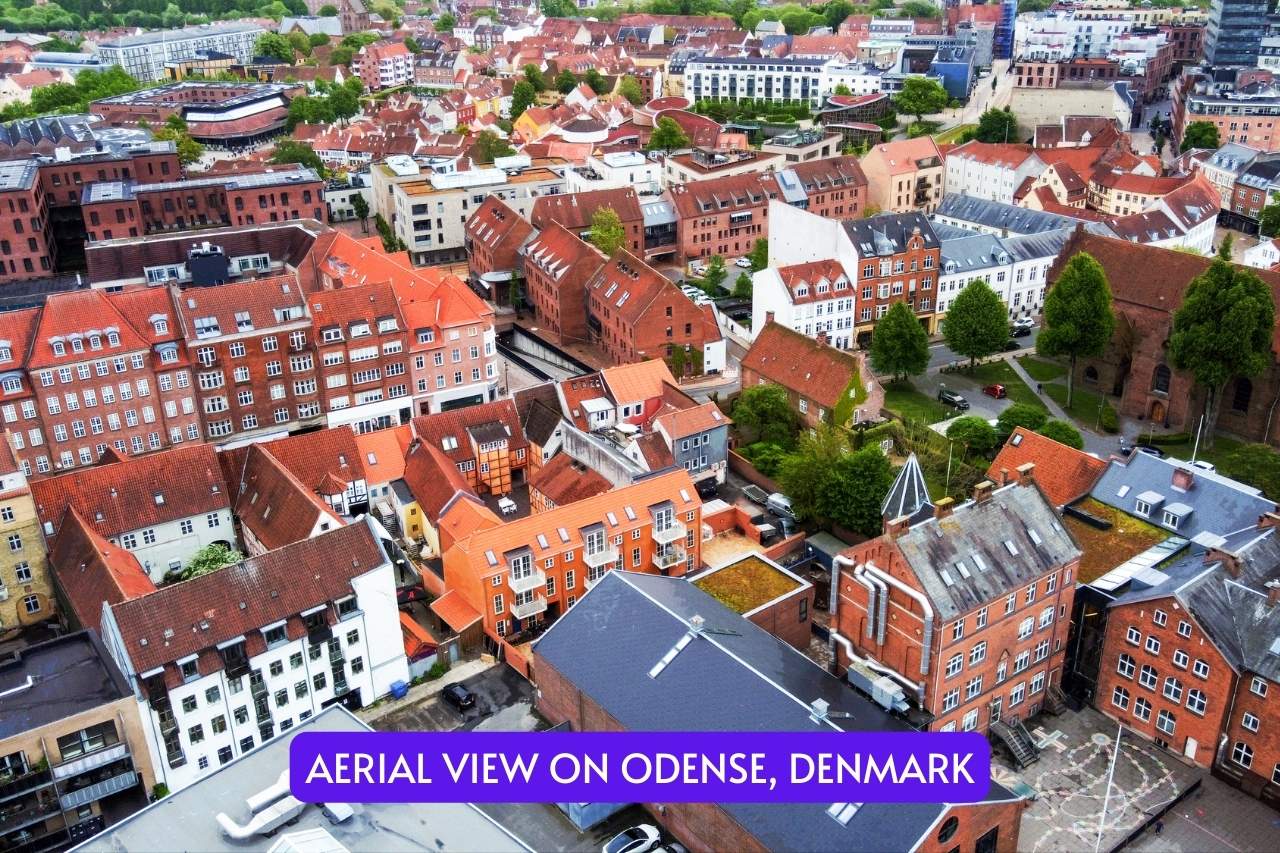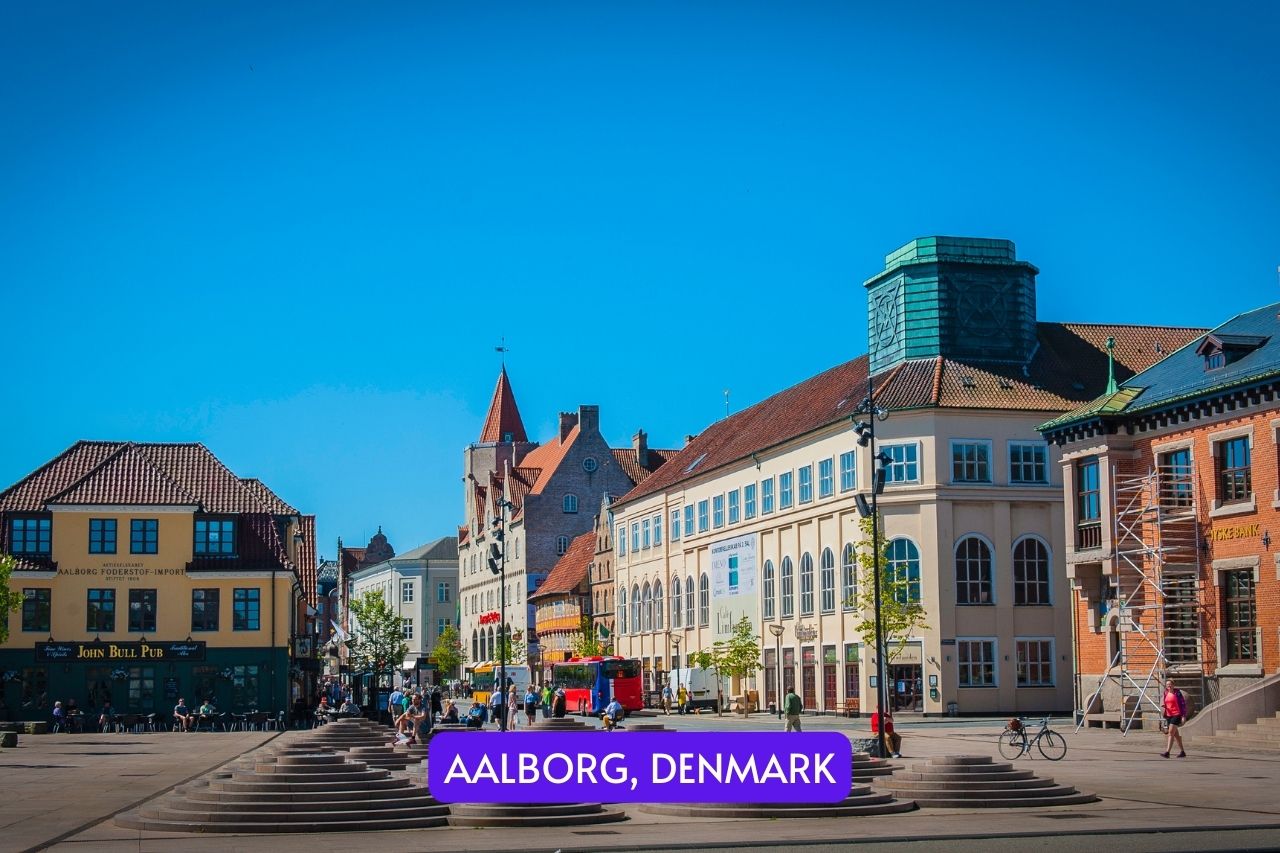Denmark is a global cultural powerhouse that is home to well-known eateries, designers, TV series, and lifestyle ideas. The nation is a joy to tour, with its modern capital, sunny beaches, charming villages, and unique islands.
Copenhagen
Refined, international, and effortlessly stylish, Copenhagen is little wonder it’s frequently listed as one of the world’s happiest cities. Explore the Danish capital like a native by taking a bike ride along its cobblestone streets, eating at internationally recognized restaurants serving up fresh, locally produced food, and enjoying the hygge philosophy in welcoming cafés. A list of the landmarks that visitors may see includes Nyhavn, Amalienborg Palace, Tivoli Gardens, and the Little Mermaid. Add fantastic museums and expansive green areas, and you’ll find no shortage of things to do in Copenhagen.

Little Mermaid (Lille Havfrue)
- Address: Langelinie, 2100 København Ø, Denmark
- Opening hours: All day
- Entrance fee: Free
The Little Mermaid, a gift from Danish brewer Carl Jacobsen to the City of Copenhagen, was unveiled on August 23, 1913. At Langelinie Pier, a granite and bronze. The Little Mermaid, a popular symbol in Denmark, had her debut in Hans Christian Andersen’s well-known story and gained much more notoriety when she starred in Disney’s 1989 animated version. This is one of the most visited tourist destinations in Copenhagen, which can be seen above the harbor.
Nyhavn
- Address: Kobenhavn K, Copenhagen, Denmark
- Opening hours: All day
- Entrance fee: Free
Although Nyhavn, a thriving entertainment zone, was initially founded in the 17th century, its name translates to “new harbor” in Danish. One of Copenhagen’s most charming locations is the waterfront Nyhavn neighborhood, which has a canal surrounded by townhouses painted in vibrant colors as well as quaint pubs, eateries, and cafés. Year-round tourists are drawn to the area by its cobblestone streets, sailboats, and clean houseboats, which all contribute to its old-world charm.
Tivoli Gardens
- Address: Vesterbrogade 3, 1630 København V, Denmark
- Opening hours: 11:00 – 22:00
- Entrance fee as follows
| Type of ticket | Category | Fee (DKK) |
| Entrance | Child under 03 years old | Free |
| Child 03-07 years old | 70 | |
| Person from 08 years old | 155 | |
| Ride Passes | 259 |
One of the most well-known amusement parks in Europe and the oldest continuously running theme park in the world, Tivoli Gardens in Copenhagen opened its doors in 1843 and served as the inspiration for Disneyland in the US. Tivoli retains its classic vibe and charming quaintness while providing a bustling mix of attractions, gardens, and restaurants. It is home to the Himmelskibet, one of the highest chain carousels in the world, as well as a number of thrilling roller coasters, such as the well-liked Rutsjebanen wooden coaster. Take a hot-air balloon trip on the Ferris wheel for breathtaking views of the park.
Rosenborg Castle
- Address: Øster Voldgade 4A, 1350 København, Denmark
- Opening hours: 10:00 – 16:00 (except Monday)
- Entrance fee as follows
| Type of ticket | Category | Fee (DKK) |
| Admission Ticket | Child under 18 years old | Free |
| Student | 90 | |
| Adult | 140 | |
| The Queens of Rosenborg | + 30 |
Danish architect King Christian IV constructed Copenhagen’s Rosenborg Castle (also known as Rosenborg Slot) in the early 17th century in the Dutch Renaissance style, which was common to Danish construction at the period. The castle, which served as the king’s summer residence in the past, is now home to a museum featuring the Royal Collections, magnificent artifacts that illustrate the development of Danish royal culture from the late 16th to the 19th century. These include the Danish Crown Jewels, which are especially impressive because of Christian IV’s glittering crown and Christian III’s sword covered in jewels; Royal Regalia; furnishings from coronations; and family portraits. The top chambers of the castle house royal heirlooms organized chronologically by king.
The Round Tower
- Address: Købmagergade 52A, 1150 København, Denmark
- Opening hours: 10:00 – 18:00 (Thursday – Monday) | 10:00 – 21:00 (Tuesday – Wednesday)
- Entrance fee as follows
| Category | Fee (DKK) |
| Child under 05 years old | Free |
| Child 05-15 years old | 10 |
| Adult | 40 |
The oldest operational observatory in Europe is supposedly Copenhagen’s Round Tower (Rundetårn), which dates back to the 17th century. The tower is frequented by tourists seeking fantastic city views during the day and amateur astronomers at night, despite the fact that there are no longer any scientists on duty. A spiral ramp that leads to windows at varying heights providing views of the city allows visitors to climb the tower. The former university library, which now doubles as a gallery and performance space, is where author Hans Christian Andersen once went for inspiration for his fairytales. An observation platform with expansive views of the ancient city and a glass floor that lets you glimpse into the hollow core of the structure is located at the summit of the tower.
Amalienborg Palace
- Address: Amalienborg Slotsplads 5, 1257 København K, Denmark
- Opening hours: 10:00 – 15:00 (Tuesday – Friday) | 10:00 – 16:00 (Saturday – Sunday)
- Entrance fee as follows
| Category | Fee (DKK) |
| Child under 18 years old | Free |
| Student | 80 |
| Adult | 125 |
The formal home of the oldest monarchy in the world, the Danish royal family, is Amalienborg Palace. A well-liked tourist destination and one of Copenhagen’s most exquisite landmarks, the Amalienborg complex is home to four opulent palaces: Christian VII’s Palace, Frederik VIII’s Palace, Christian IX’s Palace, and Christian VIII’s Palace. You may travel behind the scenes at a real royal palace and explore the seat of one of the oldest kingdoms in the world. For those interested in royal history, a visit to the palace is essential. Don’t miss the magnificent ceremony of the changing of the guards on the palace square.
Christiansborg Palace
- Address: Prins Jørgens Gård 1, 1218 København, Denmark
- Opening hours: 10:00 – 17:00 (except Monday)
- Entrance fee as follows
| Type of ticket | Category | Fee (DKK) |
| The Royal Reception Rooms | Child under 18 years old | Free |
| Student | 95 | |
| Adult | 105 | |
| The Royal Kitchen | Child under 18 years old | Free |
| Student | 55 | |
| Adult | 65 | |
| The Ruins | Child under 18 years old | Free |
| Student | 55 | |
| Adult | 65 | |
| The Royal Stables | Child under 18 years old | Free |
| Student | 55 | |
| Adult | 65 | |
| The Palace Chapel | Free | |
| The Parliament | Free | |
| All in one | Child under 18 years old | Free |
| Student | 155 | |
| Adult | 175 |
Christiansborg Palace, which served as the Danish kings’ primary residence for many years, is currently the center of government in Denmark and is home to the parliament, prime minister’s office, and supreme court. One of Copenhagen’s most recognizable sites, Christiansborg is home to more than 800 years of Danish history. With a guided tour, you can explore the magnificent Royal Banqueting Hall, the Throne Room, the place where Danish kings are crowned, the exquisitely furnished Queen’s Library, and the Great Hall, which is home to a collection of tapestries that depict Denmark’s history. The Parliament buildings, Palace Chapel, Royal Stables, and on-site Theatre Museum are all open for tours. You may visit a number of medieval-era ruins that are located beneath the palace foundations.
Ny Carlsberg Glyptotek
- Address: Dantes Plads 7, 1556 København, Denmark
- Opening hours: 10:00 – 17:00 (except Monday)
- Entrance fee: 125 DKK/adult & 95 DKK/person under 27 years old or student
Ancient and contemporary art are on exhibit at Ny Carlsberg Glyptotek in quite unusual settings. Carl Jacobsen, a brewer, founded the gallery in 1897. It is well-known for its marble statues and winter garden. Enter to see a stunning structure with vaulted ceilings and a striking winter garden including palm palms encircling a pond and fountain.
Ancient Greek and Roman portrait heads and a sizable collection of Palmyrene portraits are among the many pieces of ancient sculpture in the collection. In addition to a collection of artwork from the Danish Golden Age, the collection’s contemporary section include French sculpture from the 19th century, which contains a sizable number of pieces by Auguste Rodin, and French painting from 1800 to 1950, which is dominated by Impressionism and Paul Gauguin. The majority of the collection is included in the museum’s permanent displays, but there are also occasionally scheduled special exhibitions that, with the use of loaned art, contribute in the development of an understanding of the collection.
National Museum of Denmark
- Address: Ny Vestergade 10, 1471 København K, Denmark
- Opening hours: 10:00 – 17:00 (except Monday)
- Entrance fee: 130 DKK/adult & free for child under 18 years old
Experience Denmark’s history from the earliest Mesolithic hunters to the final hash booth from Christiania at the National Museum of Denmark, located in the center of Copenhagen. The Viking treasure, the tomb of the Egtved girl, Egyptian mummies, Renaissance artwork, and modern art are all on display in the National Museum.
Aside from the numerous riches to be found, guests are welcomed to Attend the Vikings, an exhibition that recreates Queen Tove’s appearance alongside warrior beserkers, housewives, and peasants, many of whom are shown donning jewelry from Denmark’s biggest treasure hoards.
Prominent national treasures like the almost 3,000-year-old Sun Chariot, the Bronze Age Egtved Girl, and an amazing collection of Viking-era archeological artifacts are all part of another important permanent display on Danish antiquity. Additionally on display is the Huldremose Woman, whose exceptionally well-preserved bones are said to have been created in the first ten years of the first century AD.
Aarhus
Aarhus, also known as Århus, is the second biggest city in Denmark. It is located on Jutland’s east coast, where the Aarhus Å river empties into the charming bay by the same name. As you visit the city’s various tourist attractions, you’ll see several well-preserved Renaissance structures that attest to the wealth earned by merchants during the city’s early glory.

The Old Town
- Address: Viborgvej 2, 8000 Aarhus C, Denmark
- Opening hours: 10:00 – 16:00
- Entrance fee as follows
| Category | Fee (DKK) |
| Child under 18 years old | Free |
| Student | 65 |
| Adult | 125 |
A unique outdoor museum, Den Gamle By, often known as “The Old Town,” is made up of about seventy-five antique structures that have been gathered from all across Denmark. This amazing collection, which spans the 16th to the early 20th century, has been put together as though it were a true “old town.” The fact that these magnificent old homes, businesses, workshops, and windmills continue to operate exactly as they did in the past and act as a time capsule conserving a bygone age.
One of the highlights of a visit is the 1597 former Burgomaster’s mansion, which has a remarkable collection of furnishings and is exceptionally well-preserved. The merchant’s home, a warehouse, a two-story stone building, and a stilt house are also noteworthy. The grand Coin Master’s Mansion, a more recent “old” addition constructed on the property in 2009, is the biggest structure.
Not to be missed are the historical musical collection, textile museum, and toy museum. The apothecary’s shop, which has medicinal plants, the bicycle museum, and the former coopers’, shoemakers’, and candlemakers’ workshops are all still there. Historical costume displays are another notable event hosted by the museum.
AroS Aarhus Art Museum
- Address: Aros Allé 2, 8000 Aarhus, Denmark
- Opening hours: 10:00 – 21:00 (Tuesday – Friday) | 10:00 – 17:00 (Saturday – Sunday)
- Entrance fee as follows
| Category | Fee (DKK) |
| Child under 18 years old | Free |
| Student | 145 |
| Young People under 31 years old | 145 |
| Adult | 175 |
One of the biggest art museums in Europe is the ARoS Aarhus Kunstmuseum, located in Aarhus, Denmark. Your Rainbow panorama is the most amazing architectural piece in the museum, housed in a spectacular 10-story edifice that is a work of art in and of itself.
Danish-Icelandic artist Olafur Eliasson built this amazing circular pathway, encircled by glass in a rainbow of hues. The promenade is 150 meters long and three meters wide, mounted on columns that are 3.5 meters above the ceiling. You’ll get rainbow-colored views of the water and city as you go around it. The 310 square meter Roof Pavilion is where you may enter Your Rainbow. Danish Modernism (1900–1960s), modern art, and artwork from the Danish Golden Age (1770–1900) are among the collections’ highlights.
Moesgaard Museum
- Address: Moesgård Allé 15, 8270 Højbjerg, Denmark
- Opening hours: 10:00 – 17:00 (except Monday)
- Entrance fee as follows
| Category | Fee (DKK) |
| Child under 18 years old | Free |
| Student | 110 |
| Adult | 180 |
MOMU, the excellent Moesgård Museum, is located just a short drive south of Aarhus. Constructed on the premises of the storied Moesgård manor house, which formerly served as the home of the old museum, this tastefully designed attraction debuted in fall 2014 and provides a thorough history of Denmark spanning from the Stone Age to the Viking era. One very well-liked sight is the Grauballe Man (Grauballemann), a wonderfully preserved body discovered in a neighboring swamp that dates back more than 2,000 years. An enjoyable walk is the Prehistoric Trail (Oldtidssti) in the museum’s outdoor area. This enjoyable walk winds across the estate’s fields and forests, passing model homes from the Paleolithic era and burial mounds.
Tivoli Friheden
- Address: Skovbrynet 5, 8000 Aarhus, Denmark
- Opening hours: 11:30 – 20:00
- Entrance fee: 175 DKK
Tivoli Friheden is a family-friendly theme park that is about two kilometers from Aarhus’s downtown and a short stroll from Marselisborg Forest. It is sure to provide hours of entertainment for kids. A 5D Cinemagic theater, games, playgrounds, and themed rides are among its more than 40 attractions. In addition, there are eateries and souvenir sellers in the park, and Danish and foreign performers perform there on occasion. Holiday events introduce fresh Halloween and Christmas décor, particularly during the stunning light show.
Botanical Garden
- Address: Møllevejen, Peter Holms Vej 10A, 8000 Aarhus, Denmark
- Opening hours: 09:00 – 16:00 (Monday – Friday) | 10:00 – 17:00 (Saturday – Sunday)
- Entrance fee: Free
Established in 1875, the 53-acre Aarhus Botanical Garden (also known as Botanisk Have) is a remarkable space. The huge greenhouses with tropical plants from all over the world are highlights. Big plant collections from across the world that may be cultivated in four distinct climatic zones are available to visitors thanks to recent renovations that included the building of a big tropical dome. Summertime brings many of activities for kids to enjoy, such as concerts and shows in the garden’s amphitheater, as well as unique children’s programs.
Odense
Odense, named after the Norse God of war, knowledge, and poetry, Odin, is located in the middle of Funen, Denmark’s garden island, which is home to several exquisite manor homes and palaces. Tourists are most familiar with it as the birthplace of beloved fairy tale creator Hans Christian Andersen. The outstanding Hans Christian Andersen Museum and his boyhood house are the city’s most visited tourist destinations.

Egeskov Castle
- Address: Egeskov Gade 22, 5772 Kværndrup, Denmark
- Opening hours: 10:00 – 16:00
- Entrance fee: 140 DKK/adult & 95 DKK/child 04-12 years old
The greatest preserved moat-castle in Europe, the fairy tale Egeskov Castle, is less than 30 minutes’ drive from Odense. Frands Brockenhuus finished constructing the present building in 1554. It’s a magnificent recreation of a water castle from the Renaissance. Between the fourteenth and sixteenth centuries, the European Renaissance was a very fashionable architectural movement. It is distinguished by its geometric, proportionate, and symmetrical conformance, which is reminiscent of the architectural styles of the classical Greeks and Romans.
During a period of political and theological turmoil, this magnificent Renaissance architecture was built as a protective construction; despite the calm around it now. It was built with thick enough walls to contain stairways and a well to supply water in the case of a siege, protecting it from attack by being situated in the center of a lake. Today, visitors may explore the many museums, galleries, and gardens at this stunning castle, which is accessible to the general public!
Odense Zoo
- Address: Søndre Blvd. 306, 5000 Odense C, Denmark
- Opening hours: 09:00 – 16:00
- Entrance fee: 230 DKK/adult & 130 DKK/child 03-11 years old
Odense Zoo, rated as one of Europe’s top little zoos, is just a short 3.5 kilometers from the city and offers a wide range of interesting activities. Penguins, zebras, sloths, camels, ostriches, tapirs, flamingos, red pandas, Shetland ponies, alpacas, and chimpanzees are just a few of the astounding variety of animals. You may even spend the night camping on the property in the summer (minimum four persons) and receive a guided tour that takes you behind the scenes.
The Funen Village
- Address: Sejerskovvej 20, 5260 Odense, Denmark
- Opening hours: 10:00 – 16:00
- Entrance fee: 145 DKK/adult & free for child
The Funen Village focuses on how living sustainably in the past has inspired people to live more sustainably in the present. It also highlights how people have lived more in harmony with nature and in circles. Every structure is derived from Funen and dates back to the 18th and 19th centuries. Most have thatched roofs and are constructed with half-timbering. There are fields and gardens all around the village, and you may see cattle in the fields, on pasture, or in stables where the farmer is tilling the arable land.
Danmarks Jerbanemuseum
- Address: Dannebrogsgade 24, 5000 Odense, Denmark
- Opening hours: 10:00 – 16:00 (Monday – Friday) | 09:00 – 16:00 (Saturday – Sunday)
- Entrance fee as follows
| Type of ticket | Category | Fee (DKK) |
| Entrance Ticket | Child | Free |
| Student | 105 | |
| Adult | 120 | |
| Senior | 105 | |
| Runs | 100 |
Wonderful Railway Museum with an unusual collection of 19th-century locomotives, just around 1.5 km from Odense Cathedral. You may relive everything from the heyday of steam locomotives to the more contemporary era of diesel trains here. The roundhouse, which was first built as an engine factory for DSB and the private North Funen Railway Company, is now a striking display area where visitors may learn about the background of Danish railways. There are frequent visiting locomotives in addition to the magnificent and extensive permanent collection, which features double-decker carriages and a Royal Saloon Car.
H.C. Andersens House
- Address: H.C. Andersen Haven 1, 5000 Odense C, Denmark
- Opening hours: 10:00 – 16:00 (except Monday)
- Entrance fee: 165 DKK/adult & free for child under 18 years old
Andersen’s Barndomshjem, the boyhood home of Hans Christian Andersen, is located on Munkemøllestraede (3-5) southwest of Odense Cathedral. A commemorative plaque is located on the gable end of the house. The Hans Christian Andersen Museum, which was established in 1908 and is devoted to the writer’s life and work, uses antiques, souvenirs, and exhibitions to delve further into Andersen’s universe.
Aalborg
Aalborg, Denmark’s fourth-biggest city, is rich in both history and culture. Aalborg is a city in the province of North Jutland in the country’s north. This city is ideal for a weekend visit with friends, family, or even if you’re traveling alone because it offers a ton of architectural wonders, museums, lovely squares, and parks.

Kunsten Museum of Modern Art Aalborg
- Address: Kong Christians Alle 50, 9000 Aalborg, Denmark
- Opening hours: 10:00 – 21:00 (Tuesday – Thursday) | 10:00 – 17:00 (Friday – Sunday)
- Entrance fee as follows
| Category | Fee (DKK) |
| Child under 18 years old | Free |
| Student | 90 |
| Adult | 130 |
After extensive renovations, Kunsten, the Museum of Modern Art in Aalborg, reopened in 2016 with a fresh new appearance. The globally renowned Finnish architect Alvar Aalto, together with Elissa Aalto and Jean-Jacques Baruël, created a structure that is really exceptional. Kunsten resembles a sculpture that emerges from its surroundings to form a stunning backdrop for internationally renowned artwork. Numerous visitors examine Kunsten’s collection of modern art each year. Visitors and locals alike swarm to the museum in Aalborg to see the amazing structure and take in the exceptional collection of modern and contemporary art.
Aalborg Zoo
- Address: Mølleparkvej 63, 9000 Aalborg, Denmark
- Opening hours: 10:00 – 15:00
- Entrance fee as follows
| Category | Fee (DKK) |
| Child 03-11 years old | 140 |
| Student | 188 |
| Adult | 235 |
Families traveling to Aalborg, Denmark, with an affinity for animals should definitely check out the Aalborg Zoo. For guests of all ages, the city’s center zoo provides an entertaining and instructive experience. The Aalborg Zoo, which is home to over 1,500 species from all over the world, is well known for its commitment to conservation and giving its inhabitants a natural habitat. A vast array of animals, such as lions, giraffes, elephants, monkeys, penguins, and many more, may be seen by guests as they tour the zoo.
Wikingermuseum Lindholm Høje
- Address: Vendilavej 11, 9400 Nørresundby, Denmark
- Opening hours: 10:00 – 16:00 (except Monday)
- Entrance fee as follows
| Category | Fee (DKK) |
| Child under 18 years old | Free |
| Student | 85 |
| Adult | 100 |
One of the most popular attractions in Aalborg, Denmark, is the Lindholm Høje Museum. This archeological museum, which is situated outside of the city, provides a fascinating look into the history of the area throughout the Viking and Iron ages. Situated on the Lindholm Høje site, which is renowned for its vast Viking burial mounds and prehistoric villages, lies the museum. Explore the intact burial mounds and get a sense of the way of living in this era.
The museum itself has a variety of Viking-related relics and exhibitions, such as jewelry, weaponry, and commonplace items. Additionally, there are educational panels and interactive exhibits that give a thorough account of Lindholm Høje’s significance and history.

